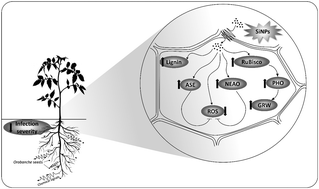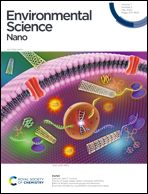Silicon dioxide nanoparticles alleviate the threats of broomrape infection in tomato by inducing cell wall fortification and modulating ROS homeostasis†
Abstract
Infestation by parasitic weeds is one of the most important environmental challenges threatening cropping systems worldwide. Among these, branched broomrape (Orobanche ramosa), a root holoparasitic weed, detrimentally affects many crops especially tomato (Lycopersicon esculentum) and causes severe crop losses. The positive role of silicon nanoparticles (SiNPs) in the growth and yield of plants grown under stressful conditions has been reported. However, no study has investigated the impact of SiNPs on plant–weed interaction. In this study, we conducted a green-house experiment to assess the physiological implications of SiNPs on tomato under the Orobanche challenge. Orobanche infection alone markedly inhibited tomato growth and photosynthesis (P < 0.0001) and induced oxidative damage via increased photorespiration (P < 0.0001) and NADPH oxidase activities (P < 0.01). Interestingly, SiNPs significantly reduced the infection severity by reducing both the number and biomass of Orobanche tubercles (13 and 31% decrease, respectively). Moreover, SiNPs dramatically ameliorated the physiological and biochemical disorders imposed by Orobanche in tomato. Consistently, SiNPs strengthened the cell wall of host roots by upregulating lignin biosynthesis that acts as a physical barrier against tubercle haustorial penetration. On the other hand, SiNPs caused a noticeable decrease in ROS production and improved both enzymatic and non-enzymatic detoxification systems, the thing that was more pronounced in roots than in shoots of infected tomato plants. Such organ-specific responses were confirmed by cluster analysis. Overall, this study suggests that tomato plants treated with SiNPs will be more tolerant to Orobanche infection through enhanced structural and metabolic responses.



 Please wait while we load your content...
Please wait while we load your content...